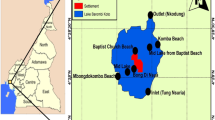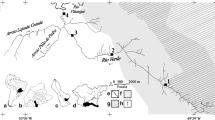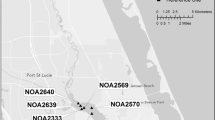Abstract.
Contaminants entering aquatic systems from agricultural, industrial, and municipal activities are generally sequestered in bottom sediments. The environmental significance of contaminants associated with sediments dredged from Savannah Harbor, Georgia, USA, are unknown. To evaluate potential effects of contaminants in river sediments and sediments dredged and stored in upland disposal areas on fish and wildlife species, solid-phase sediment and sediment pore water from Front River, Back River, an unnamed Tidal Creek on Back River, and Middle River of the distributary system of the lower Savannah River were tested for toxicity using the freshwater amphipod Hyalella azteca. In addition, bioaccumulation of metals from sediments collected from two dredge-disposal areas was determined using the freshwater oligochaete Lumbriculus variegatus. Livers from green-winged teals (Anas crecca) and lesser yellowlegs (Tringa flavipes) foraging in the dredge-spoil areas and raccoons (Procyon lotor) from the dredge-disposal/river area and an upland site were collected for metal analyses. Survival of H. azteca was not reduced in solid-phase sediment exposures, but was reduced in pore water from several locations receiving drainage from dredge-disposal areas. Basic water chemistry (ammonia, alkalinity, salinity) was responsible for the reduced survival at several sites, but PAHs, metals, and other unidentified factors were responsible at other sites. Metal residues in sediments from the Tidal Creek and Middle River reflected drainage or seepage from adjacent dredge-disposal areas, which could potentially reduce habitat quality in these areas. Trace metals increased in L. variegatus exposed in the laboratory to dredge-disposal sediments; As, Cu, Hg, Se, and Zn bioaccumulated to concentrations higher than those in the sediments. Certain metals (Cd, Hg, Mo, Se) were higher in livers of birds and raccoons than those in dredge-spoil sediments suggesting bioavailability. Cadmium, Cr, Hg, Pb, and Se in livers from raccoons collected near the river and dredge-disposal areas were significantly higher than those of raccoons from the upland control site. Evidence of bioaccumulation from laboratory and field evaluations and concentrations in sediments from dredge-disposal areas and river channels demonstrated that some metals in the dredge-disposal areas are mobile and biologically available. Drainage from dredge-disposal areas may be impacting habitat quality in the river, and fish and wildlife that feed and nest in the disposal areas on the lower Savannah River may be at risk from metal contamination.
Similar content being viewed by others
Author information
Authors and Affiliations
Additional information
Received: 21 October 1998/Accepted: 9 February 1999
Rights and permissions
About this article
Cite this article
Winger, P., Lasier, P., White, D. et al. Effects of Contaminants in Dredge Material from the Lower Savannah River. Arch. Environ. Contam. Toxicol. 38, 128–136 (2000). https://doi.org/10.1007/s002449910016
Issue Date:
DOI: https://doi.org/10.1007/s002449910016




